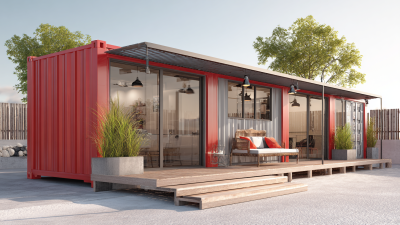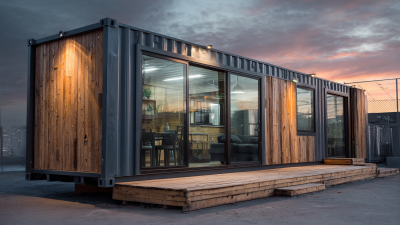 The logistics and storage industry is undergoing a significant transformation with the emergence of innovative solutions like Flat Pack Containers. These versatile storage options not only optimize space utilization but also promote sustainability, aligning with the global shift towards eco-friendly practices. According to a recent report by Grand View Research, the global storage industry is projected to reach $6.1 billion by 2025, driven by the increasing demand for efficient and sustainable storage solutions. Flat Pack Containers, known for their ease of transportation and assembly, account for a substantial portion of this growth, appealing to both businesses and consumers looking to minimize their ecological footprint. Moreover, a study by McKinsey & Company highlights that adopting sustainable practices in packaging can reduce costs by up to 20%, further emphasizing the practical advantages of Flat Pack Containers in today's market. As we explore the myriad benefits and applications of this innovative storage solution, it becomes clear that Flat Pack Containers are revolutionizing the way we think about storage, sustainability, and versatility.
The logistics and storage industry is undergoing a significant transformation with the emergence of innovative solutions like Flat Pack Containers. These versatile storage options not only optimize space utilization but also promote sustainability, aligning with the global shift towards eco-friendly practices. According to a recent report by Grand View Research, the global storage industry is projected to reach $6.1 billion by 2025, driven by the increasing demand for efficient and sustainable storage solutions. Flat Pack Containers, known for their ease of transportation and assembly, account for a substantial portion of this growth, appealing to both businesses and consumers looking to minimize their ecological footprint. Moreover, a study by McKinsey & Company highlights that adopting sustainable practices in packaging can reduce costs by up to 20%, further emphasizing the practical advantages of Flat Pack Containers in today's market. As we explore the myriad benefits and applications of this innovative storage solution, it becomes clear that Flat Pack Containers are revolutionizing the way we think about storage, sustainability, and versatility.
Flat pack containers are revolutionizing modern storage solutions, offering unparalleled versatility and sustainability. Originally designed for efficient shipping, these containers have evolved to serve a multitude of purposes across various sectors, including residential, commercial, and recreational settings. Their modular design allows for easy transport and assembly, making them ideal for users looking to optimize space without compromising aesthetic appeal.
The benefits of flat pack containers extend beyond simple storage. They can be customized to fit specific needs, making them perfect for everything from camping gear organization to creative home decor solutions. For instance, innovative DIY hacks have emerged, encouraging users to repurpose flat pack designs to create unique storage solutions like vinyl record holders or efficient closet organizers. This adaptability not only enhances functionality but also promotes sustainability by maximizing the use of available materials, aligning with the growing demand for environmentally-friendly solutions in our storage practices.
Flat pack technology stands at the forefront of innovative storage solutions, enabling the maximization of space without sacrificing functionality. By allowing containers to be assembled and disassembled effortlessly, this approach transforms traditional storage methods. The design of flat pack containers facilitates easy transportation, drastically reducing costs associated with shipping and storage. When not in use, these containers can be collapsed to save significant amounts of space, making them ideal for both personal and commercial applications where space is at a premium.
Moreover, the versatility of flat pack containers is highlighted through their ability to adapt to various environments and needs. They come in a range of sizes and configurations, providing tailored solutions for diverse storage challenges. Whether used in warehouses, during relocation, or for temporary events, flat pack containers merge practicality with creativity. The ability to customize and optimize space not only enhances operational efficiency but also promotes sustainable practices by minimizing waste and reducing the environmental footprint associated with traditional storage solutions.
 Flat pack containers are transforming the storage and logistics industry by offering significant sustainability advantages. According to a report by the World Economic Forum, logistics accounts for nearly 10% of global CO2 emissions, emphasizing the urgent need for more sustainable practices. Flat pack containers, which can be shipped and stored in a compact form, help reduce transportation emissions by maximizing space efficiency. A study from the International Journal of Logistics Management found that using flat pack containers can decrease the carbon footprint of shipments by up to 30%, as they enable companies to transport more goods per trip.
Flat pack containers are transforming the storage and logistics industry by offering significant sustainability advantages. According to a report by the World Economic Forum, logistics accounts for nearly 10% of global CO2 emissions, emphasizing the urgent need for more sustainable practices. Flat pack containers, which can be shipped and stored in a compact form, help reduce transportation emissions by maximizing space efficiency. A study from the International Journal of Logistics Management found that using flat pack containers can decrease the carbon footprint of shipments by up to 30%, as they enable companies to transport more goods per trip.
Moreover, the use of flat pack containers contributes to waste reduction. The Sustainable Packaging Coalition estimates that packaging waste constitutes a substantial portion of landfill materials, with 30% of the waste coming from shipping containers alone. Flat pack designs, which can be easily assembled and disassembled, minimize the volume of material needed for packaging, promoting a circular economy. This adaptability not only lowers material consumption but also encourages reusability, further enhancing sustainability efforts in supply chains. Companies adopting these innovative containers are not only responding to consumer demands for eco-friendly practices but also aligning with global initiatives to reduce environmental impacts.
When selecting the right flat pack storage option, it's essential to consider factors such as material, size, and intended use. According to a report by Grand View Research, the global portable storage market is projected to reach $4.3 billion by 2025, with a significant portion of this growth driven by increased demand for versatile storage solutions. Flat pack containers are particularly popular due to their ability to be shipped and stored efficiently, reducing transportation costs by up to 30% compared to traditional storage solutions.
In addition to cost-effectiveness, sustainability is a crucial aspect of flat pack containers. The Ellen MacArthur Foundation highlights that using materials that are recyclable or made from recycled components can significantly decrease environmental impact. When choosing a flat pack storage option, look for containers made from eco-friendly materials such as plywood or high-density polyethylene (HDPE), which not only provide durability but also align with growing sustainability goals in various industries. By carefully evaluating these criteria, you can select a flat pack storage solution that meets both your functional needs and your commitment to environmental responsibility.

The evolution of flat pack containers is reshaping various industries, driven by their remarkable versatility and eco-friendly design. Traditionally used for storage and shipping, these containers are now adapting to meet the needs of urban living, retail, and even temporary housing solutions. As cities become denser and sustainability becomes paramount, flat pack containers are poised to revolutionize how we think about space and resources, offering solutions that prioritize minimalism and environmental consciousness.
**Tips:** When considering flat pack containers for your next project, think about multifunctionality. Look for designs that allow for easy transformation and adaptability, such as those with modular features that can serve various purposes. Additionally, choosing containers made from recycled materials can make your project more sustainable, reducing the environmental impact and promoting a circular economy.
As we look to the future, the applications of flat pack containers will continue to diversify. Innovations in materials and design technology are making them lighter, stronger, and more efficient. Expect to see these containers playing pivotal roles in disaster relief efforts, pop-up shops, and even as flexible workspaces, demonstrating that their potential goes far beyond just storage. The adaptability of flat pack containers not only meets immediate needs but also anticipates future challenges, paving the way for a more sustainable approach to living and working.
| Container Type | Material | Dimensions (cm) | Weight Limit (kg) | Sustainability Rating | Future Applications |
|---|---|---|---|---|---|
| Standard Flat Pack | Recycled Plastic | 120 x 80 x 60 | 300 | A+ | E-commerce, Retail |
| Stackable Container | Wood | 100 x 100 x 100 | 400 | B | Outdoor Storage, Shipping |
| Insulated Flat Pack | Polyurethane | 150 x 100 x 80 | 200 | A | Food Storage, Pharmaceuticals |
| collapsible Container | Metal | 130 x 90 x 50 | 500 | A+ | Industrial, Warehousing |






